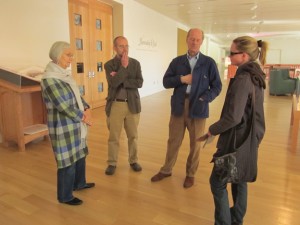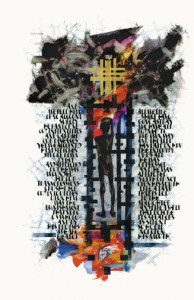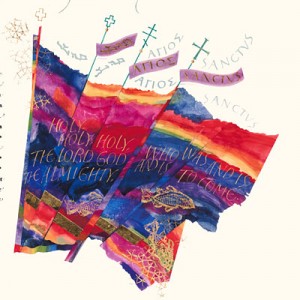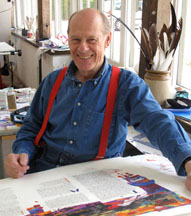Were you to spy them in a Santa Fe cafe, you might mistake Donald and Mabel Jackson for any other vacationing couple. But make no mistake: They are a power couple unlike any other power couple before them.
As a child with extraordinary artistic talents, Donald Jackson imagined writing an entire Bible in the best style of medieval monks–with careful calligraphy and inspiring illuminations. Earlier this year, he inscribed the word “Amen” onto the final page of The Saint John’s Bible, a work that has been called the Sistine Chapel of the book arts. Donald Jackson, senior scribe to Her Majesty Queen Elizabeth’s Crown Office at the House of Lords, oversaw the project from the scriptorium he and Mabel created in Wales. There, a team of scribes and artists worked hand-in-hand on page upon page.

From left: Mabel Jackson, Palace Press Director Tom Leech, Donald Jackson, and assistant collections manager Pennie McBride outside the exhibition.
Forty-four of those pages are on view through April 7 at the New Mexico History Museum, and just this week, that otherwise ordinary-looking vacationing couple dropped by to see how the exhibition looks.
Good news for us: They liked it.
“It just feels really nice walking in,” Mabel said. “It just felt good.”
Donald was particularly interested in seeing how we displayed the creation that put the entire project into motion. While at a calligraphers’ retreat at Ghost Ranch in 1994, he mocked up an art piece representing how he would approach doing a handwritten Bible. He later showed it to the Benedictine monks at Saint John’s University in Collegeville, Minn., and soon got their commission to tackle The Saint John’s Bible. The piece is on display at the museum for the first time in the project’s history.
 “That’s come out well, hasn’t it?” he said upon seeing it near the front of our exhibit, Illuminating the Word: The Saint John’s Bible and Contemplative Landscape.
“That’s come out well, hasn’t it?” he said upon seeing it near the front of our exhibit, Illuminating the Word: The Saint John’s Bible and Contemplative Landscape.
Donald Jackson will talk about The Saint John’s Bible and his life in calligraphy at 6 pm this Monday (Nov. 7) at the Lensic Performing Arts Center. The lecture costs $15; a private $50 reception follows at the History Museum. Call 505-988-1234 or go to ticketssantafe.org for tickets.
We walked around the exhibit chatting with Jackson, as fitting a preview as any to what Monday evening holds in store. Here’s a taste.
On working through difficult sections of the Bible: “You grind your teeth. There was some reaction among the scribes. Some of Leviticus, for example, was quite heavy-going–very proscriptive and dark. One of the scribes, a woman, we were writing out something that was dreary and uncomfortable, and she said, `I just realized this is like the evening news. Every night there’s something horrible.’ You look at a newspaper today, you see war, atrocities, abnormalities. She realized that this was life.
On where the scribes’ focus lay: “On the one hand, you have to experience it. On the other hand, you have to spell it right, and you’ve got to arrange it. You’re not just thinking about what it’s saying a lot of the time; you’re thinking about how you’re going to manage it.”
While trying to translate a piece of his own non-calligraphed-but-most-decidedly-scrawled handwriting that’s on display in the exhibit, Jackson could barely make out the words “green slime.” On whether there’s calligraphy hope for others with similarly wretched handwriting: “I can look at somebody whose handwriting is bad and, if it’s consistently bad, I can probably knock them into shape. To be fair, if I put you in a high-powered car and you went 100 miles per hour through downtown Santa Fe, you’d crash. If you do it too fast, it isn’t going to be good.”
To be honest: “I also have a bit of resentment about writing (non-calligraphy) things by hand. There’s something there that hasn’t got the patience to write it.”

Suffering Servant, Isaiah 53, 54:1-8, by Donald Jackson, 2005. The Saint John’s Bible, Order of Saint Benedict, Collegeville, Minnesota.
On how Ghost Ranch did or didn’t inspire The Saint John’s Bible: “It was time in the wilderness. That’s where it started. It was September, October. It was freezing. Frosty mornings and spectacular landscape. But any landscape is inspiring. Even downtown Detroit is. Flying into LA over night is. … But the truth is, it was creating the space within yourself and putting yourself into it. It’s what you bring to it as much as what it brings to you. The wilderness is frightening as well as beautiful. It’s definitely a metaphor.”
On the subversiveness of teamwork: “There were five scribes, plus me, at the scriptorium. That is a very unusual scenario. Nowadays, it’s counter-cultural, all working on one thing, all one script we’re trying to imitate. The word `artist’ in our society is synonymous with individuality. You had to be as different as you can be from the next person. … Our culture exploits that. It turns us against each other.
“To have to work together is a wonderful thing–like when you’re singing in a choir. Six people sitting in a room, all writing out sacred text. There is a noise to it, the sound of quills on vellum, the sound of occasional irritation–a mistake’s been made. Then you hear scratches of a knife raising up a comma in the wrong place. One of the most powerful things in that silence with six people is that there is a great depth of silence. It’s more silent than when you’re on your own. There’s power in that.”
On being human: “There will be mistakes in (The Saint John’s Bible). It’s not going to be perfect.”


